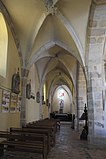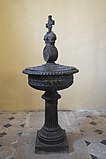Notre-Dame de l'Assomption (Marolles-en-Hurepoix)
The Catholic parish church of Notre-Dame de l'Assomption (Assumption of the Virgin), also Notre-Dame-de-l'Assomption-de-la-très-Sainte-Vierge (Assumption of the Most Holy Virgin), in Marolles-en-Hurepoix , one Commune in the Essonne department in the French region of Île-de-France , dates back to a Romanesque church from the 12th century, which was renovated in the 15th century in the Flamboyant Gothic style. The St. Mary's window in the choir and two other stained glass windows from the 16th century were added to the list of movable cultural assets ( Base Palissy ) in France in 1911 as Monuments historiques .
architecture
The oldest parts of the church are the Romanesque bell tower, which dates back to the late 11th century, and the choir , which was built at the end of the 12th century. The bell tower and the two-bay , just closed choir formed the original church. The three-aisled nave was rebuilt after the devastation during the Hundred Years War at the end of the 15th century. The main nave and the two side aisles are divided into five bays and are covered by ribbed vaults, which were only drawn in at the end of the 19th century and replace the original wooden ceiling.
Leaded glass window
The large three-lane choir window from the 16th century depicts scenes from the life of Mary in the middle. God the Father is enthroned above , below Mary stands surrounded by her symbols and praise, which can be read in the banners: "pulchra ut luna" (beautiful like the moon), "electa ut sol" (exquisite like the sun), "stella maris" (sea star), "porta coeli" (gate of heaven). The scenes below represent the Annunciation and the birth of Christ. At the bottom left and right of the picture are the donors with their patron saints and their coats of arms. Above the donors you can see a bishop on the left raising a young man from the dead, and on the right St. George , the patron saint of the parish, who defeats the dragon.
Further equipment
- The wrought-iron, partly gilded lectern dates from the late 18th century.
- The baptismal font is made of cast iron and was created in the 19th century. The round dish is godroniert , the fluted pedestal with foliage decorated. The lid is crowned by two angel heads and a cross.
- The carved figure of St. George framed in white and partially gilded comes from the 19th century and represents the patron saint of the parish.
literature
- Louis Grodecki, Françoise Perrot, Jean Taralon (eds.): Les vitraux de Paris, de la région parisienne, de la Picardie et du Nord-Pas-de-Calais . (= Corpus Vitrearum Medii Aevi ). Récensement des vitraux anciens de la France. Volume 1, Éditions du Center National de la Recherche Scientifique, Paris 1978, ISBN 2-222-02263-0 , pp. 82-83.
- Le Patrimoine des Communes de l'Essonne . Flohic Éditions, Volume 1, Paris 2001, ISBN 2-84234-126-0 , p. 146.
Web links
- Église Notre-Dame-de-l'Assomption Mairie de Marolles-en-Hurepoix
- Eglise de l'Assomption-de-Notre-Dame patrimoine-religieux
Individual evidence
- ↑ L'Assomption-de-la-très-Sainte-Vierge, Marolles-en-Hurepoix Diocèse d'Evry
- ↑ Mary's Window in Base Palissy of the French Ministry of Culture (French)
- ↑ 2 windows from the 16th century in the base Palissy of the French Ministry of Culture (French)
- ↑ Lectern in the Base Palissy of the French Ministry of Culture (French)
- ↑ Baptismal font in the Base Palissy of the French Ministry of Culture (French)
- ↑ Saint George in the Base Palissy of the French Ministry of Culture (French)
Coordinates: 48 ° 33 ′ 40 " N , 2 ° 18 ′ 14.5" E











